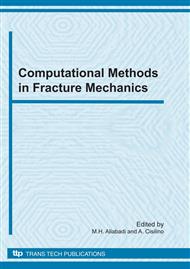[1]
G. E. Blandford, A. R. Ingraffea, and J. A. Ligget, Two dimensional stress intensity factor computation using the boundary element method. International Journal for Numerical Methods in Engineering 17: 387-404 (1981).
DOI: 10.1002/nme.1620170308
Google Scholar
[2]
J. Domdinguez and R. Gallego, Time domain boundary element method for dynamic stress intensity factor computation. International Journal of Numerical Methods in Engineering 33: 635-647 (1992).
DOI: 10.1002/nme.1620330309
Google Scholar
[3]
F. Garcia-Sanchez, C. Z. Zhang, A. Saez. A two-dimensional time-domain boundary element method for dynamic crack problems in anisotropic solids. Engineering Fracture Mechanics 75: 1412-1430 (2008).
DOI: 10.1016/j.engfracmech.2007.07.021
Google Scholar
[4]
P. Fedelinski and M. H. Aliabadi, The Dual boundary element method in dynamic fracture mechanics. Engineering Analysis with Boundary Elements 12: 203-210 (1993).
DOI: 10.1016/0955-7997(93)90016-e
Google Scholar
[5]
P. Fedelinski and M. H. Aliabadi, The Dual boundary element method: ˆJ-integral for dynamic stress intensity factors. International Journal of Fracture 65: 369-381 (1994).
DOI: 10.1007/bf00012375
Google Scholar
[6]
J. Sladek, V. Sladek, and P. Fedelinski, Computation of the second fracture parameter in elastodynamics by the boundary element method. Advances in Engineering Software 30: 725-734 (1999).
DOI: 10.1016/s0965-9978(99)00019-8
Google Scholar
[7]
E. L. Albuquerque, P. Sollero, and M. H. Aliabadi, The boundary element method applied to time dependent problems in anisotropic materials. International Journal of Solids and Structures, 39: 1405-1422 (2002).
DOI: 10.1016/s0020-7683(01)00173-1
Google Scholar
[8]
E. L. Albuquerque, P. Sollero, and M. H. Aliabadi, Dual boundary element method for anisotropic dynamic fracture mechanics. International Journal for Numerical Methods in Engineering, 59: 1187-1205 (2004).
DOI: 10.1002/nme.912
Google Scholar
[9]
A. Portela, M. H. Aliabadi, and D. P. Rooke, The dual boundary element method: Effective implementation for crack problems. International Journal for Numerical Methods in Engineering, 33: 1269-1287 (1982).
DOI: 10.1002/nme.1620330611
Google Scholar
[10]
M. Kögl and L. Gaul, A boundary element method for transient piezoelectric analysis. Engineering Analysis with Boundary Elements, 24: 591-598 (2000).
DOI: 10.1016/s0955-7997(00)00039-4
Google Scholar
[11]
J. C. Houbolt, A recurrence matrix solution for the dynamic response of elastic aircraft. Journal of Aeronautical and Science, 17: 540-550 (1950).
DOI: 10.2514/8.1722
Google Scholar
[12]
A. P. Cisilino, M. H. Aliabadi, and J. L. Otegui. Energy domain integral applied to solve center and double edge crack problems in three-dimensions. Theoretical and Applied Fracture Mechanics 29: 181-194 (1998).
DOI: 10.1016/s0167-8442(98)00029-9
Google Scholar
[13]
R. Balderrama, A. P. Cisilino, and M. Martinez. Boundary element analysis of threedimensional mixed-mode thermoelastic crack problems using the interaction and energy domain integrals. International Journal for Engineering Material 74: 294-320 (2008).
DOI: 10.1002/nme.2168
Google Scholar
[14]
B. Moran and C. F. Shih. A general treatment of crack tip contour integrals. International Journal of Fracture 35: 295-310 (1987).
DOI: 10.1007/bf00276359
Google Scholar
[15]
C. F. Shih, B. Moran, and A. Neddleman. Energy release rate along a three-dimensional crack front in a thermally stresses body. International Journal of Fracture 30: 79-102 (1986).
DOI: 10.1007/bf00034019
Google Scholar
[16]
F. Z. Li, , C. F. Shih, and A. Needleman. A comparison of methods for calculating energy release rates. Engineering in Fracture Mechanics 21: 405-421 (1985).
DOI: 10.1016/0013-7944(85)90029-3
Google Scholar
[17]
P. Sollero and M. H. Aliabadi. Crack growth analysis in homogeneous orthotropic laminates. Composites Science and Technology 58: 1697-1703 (1998).
DOI: 10.1016/s0266-3538(97)00240-6
Google Scholar
[18]
Y. M. Chen, Numerical computation of dynamic stress intensity factors by a Lagrangian finitedifference method. Engineering Fracture Mechanics, 7: 653-660 (1975).
DOI: 10.1016/0013-7944(75)90021-1
Google Scholar
[19]
Z. Hua, F. Tian-You, and T. Lan-Quao, Composite materials dynamic fracture studies by generalized Shmuely difference algorithm. Engineering Fracture Mechanics, 54: 869-877 (1996).
DOI: 10.1016/0013-7944(95)00147-6
Google Scholar


